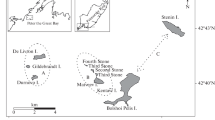Abstract
Year-round local movements of adult Japanese fluvial sculpin.Cottus pollux (large egg type), were investigated by a capture-mark-and-recapture method from July 1989 to July 1990 in the upper reaches of the Inabe River, central Japan. In the pre-breeding (July to January) and post-breeding seasons (June to July), the mean distance of movements in males and females was less than 20 m, and there was no apparent tendency to move into a particular channel-unit habitat, suggesting residential tendency in both sexes. In the breeding season (February to May), males tended to move into the raceways where most of the spawning nests were found, but females did not do likewise, indicating a sexual difference in movements in that season. Such sexual difference in movements was also confirmed by the records of individuals captured and recaptured more than three times: six (42.9%) of 14 males moved into the raceways in the breeding season, whereas only one (7.1%) of 14 females did so in that season. The reason behind this sexual difference in movements observed in the breeding season is discussed from the viewpoint of the patterns of spatial distribution between sexes during the pre-breeding and breeding seasons.
Similar content being viewed by others
Literature Cited
Bailey, J. E. 1952. Life history and ecology of the sculpin,Cottus bairdi punctulatus in southwestern Montana. Copeia, 1952: 243–255.
Balon, E. K. 1975. Reproductive guilds of fishes: a proposal and definition. J. Fish. Res. Board Can., 32: 821–864.
Brown, L. and J. F. Downhower. 1982. Summer movement of mottled sculpins,Cottus bairdi (Pisces: Cottidae). Copeia, 1982: 450–453.
Downhower, J. F., P. Lejeune, P. Gaudin and L. Brown. 1990. Movements of the chabot (Cottus gobio) in a small stream. Pol. Arch. Hydrobiol., 37: 119–126.
Erman, D. C., E. D. Andrews and M. Yoder-Williams. 1988. Effects of winter floods on fishes in the Sierra Nevada. Can. J. Fish. Aquat. Sci., 45: 2195–2200.
Freeman, M. C. and D. J. Stouder. 1989. Intraspecific interactions influence size specific depth distribution inCottus bairdi. Env. Biol. Fish., 24: 231–236.
Goto, A. 1985. Individual identification by spine and ray clipping for freshwater sculpins. Japan. J. Ichthyol., 32: 359–362.
Goto, A. 1986. Movement and population size of the river sculpinCottus hangiongensis in the Daitobetsu River of southern Hokkaido. Japan. J. Ichthyol., 32: 421–430.
Goto, A. 1987. Distribution and divergence of freshwater sculpins. Pages 156–166in N. Mizuno and A. Goto, eds. Freshwater fishes of Japan. Tokai Univ. Press, Tokyo. (In Japanese.)
Goto, A. 1988. Reproductive behavior and homing after downstream spawning migration in the river sculpin,Cottus hangiongensis. Japan. J. Ichthyol., 34: 488–496.
Goto, A. 1989. GenusCottus. Pages 648–668in H. Kawanabe and N. Mizuno, eds. Freshwater fishes of Japan. Yama-Kei Publishers, Tokyo, (In Japanese).
Goto, A. 1990. Alternative life-history styles of Japanese freshwater sculpins revisited. Env. Biol. Fish., 24: 241–249.
Goto, A. 1993. Male mating success and female mate choice in the river sculpin,Cottus nozawae (Cottidae). Env. Biol. Fish., 37: 347–353.
Greenberg, L. A. and D. A. Holtzman. 1987. Microhabitat utilization, feeding periodicity, home range and population size of the banded sculpin,Cottus carolinae. Copeia, 1987: 19–25.
Grossman, G. D., R. T. Ratajczak, Jr. and M. K. Crawford. 1995. Do rock bass (Ambloplites rupestris) induce microhabitat shifts in mottled sculpin (Cottus bairdi)? Copeia, 1995: 343–355.
Hill, J. and G. D. Grossman. 1987. Home range estimates for three North American stream fishes. Copeia, 1987: 376–380.
Kani, T. 1944. Ecology of torrent-inhabiting insects. Pages 171–317in H. Furukawa, ed. Insects I. Kenkyu-sha, Tokyo. (In Japanese).
Kani, T. 1981. Stream classification in “Ecology of torrent-inhabiting insects” (1944): An abridged translation. Physiol. Ecol. Japan. 18: 113–118.
Keenleyside, M. H. A. 1979. Diversity and adaptation in fish behaviour. Springer-Verlag, Berlin. 208 pp.
Koyama, H. 1950. Ecological studies ofCottus pollux Günther in Chikuma River. I. On living condition and breeding habits. Bull. Japan. Soc. Sci. Fish., 16: 5–12. (In Japanese with English summary).
Krejsa, R. J. 1967. The systematic of the prickly sculpin,Cottus asper Richardson, a polytypic species. Part II. Studies on the life history, with especial reference to migration. Pac. Sci., 21: 414–422.
Kuroda, N. 1947. Studies on kamakiri (Cottus kazika Jordan & Starks). Zool. Mag., 57: 101–103. (In Japanese).
Miyadi, D., H. Kawanabe and N. Mizuno. 1978. Colored illustrations of the freshwater fishes of Japan. Hoikusha, Osaka. 462 pp. (In Japanese).
Mizuno, N. and K. Gose. 1972. Ecology of rivers. Tsukiji Shokan, Tokyo. 247 pp. (In Japanese).
Morgan, C. R. and N. H. Ringler. 1992. Experimental manipulation of sculpin (Cottus cognatus) populations in a small stream. J. Freshw. Ecol., 7: 227–232.
Natsumeda, T., S. Kimura and Y. Nagata. 1997. Sexual size dimorphism, growth and maturity of the Japanese fluvial sculpin,Cottus pollux (large egg type) in the Inabe River, Mie Prefecture, central Japan. Ichthyol. Res., 44: 43–50.
Natsumeda, T. In press. Home range of the Japanese fluvial sculpin,Cottus pollux, in relation to nocturnal activity patterns. Env. Biol. Fish.
Nikolsky, G. V. 1963. The ecology of fishes. Academic Press, London. 352 pp.
Northcote, T. G. 1978. Migratory strategies and production in freshwater fishes. Pages 326–359in S. D. Gerking, ed. Ecology of freshwater fish production. Bleckwell Scientific Publication, Oxford.
Potts, G. W. 1984. Parental behaviour in temperate marine teleosts with special reference to the development of nest structure. Pages 223–244in G. W. Potts and R. J. Wootton, eds. Fish reproduction: strategies and tactics. Academic Press, London.
Quinn, T. P. and A. H. Dittman. 1992. Fishes. Pages 145–211in F. Papi, ed. Animal homing. Chapman & Hall, London.
Shimizu, Y. and S. Mori. 1985. Fish fauna of the Inabe River, Mie Prefecture. Tansuigyo, 11: 135–142. (In Japanese).
Wootton, R. J. 1990. Ecology of teleost fishes. Chapman & Hall, London. 404 pp.
Author information
Authors and Affiliations
About this article
Cite this article
Natsumeda, T. Year-round local movements of the japanese fluvial sculpin,Cottus pollux (large egg type), with special reference to the distribution of spawning nests. Ichthyological Research 46, 43–48 (1999). https://doi.org/10.1007/BF02674946
Received:
Revised:
Accepted:
Issue Date:
DOI: https://doi.org/10.1007/BF02674946




